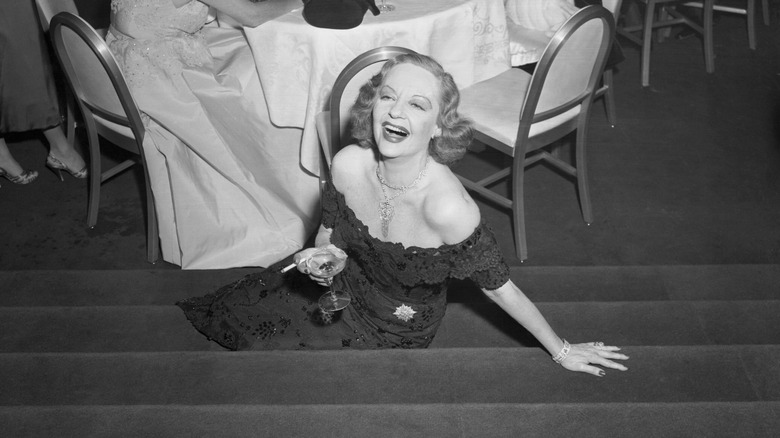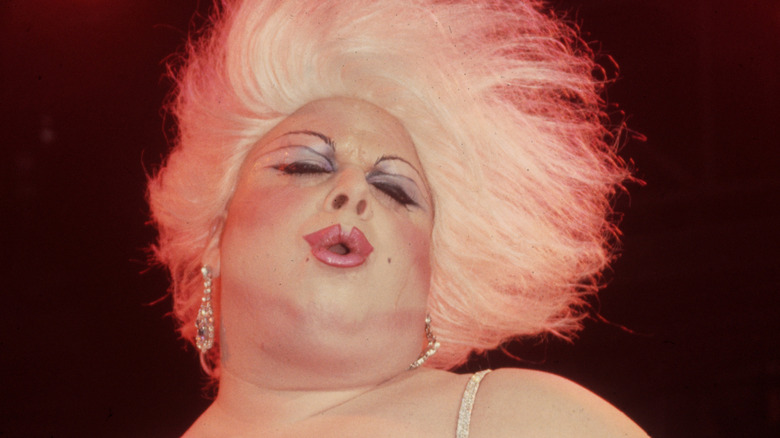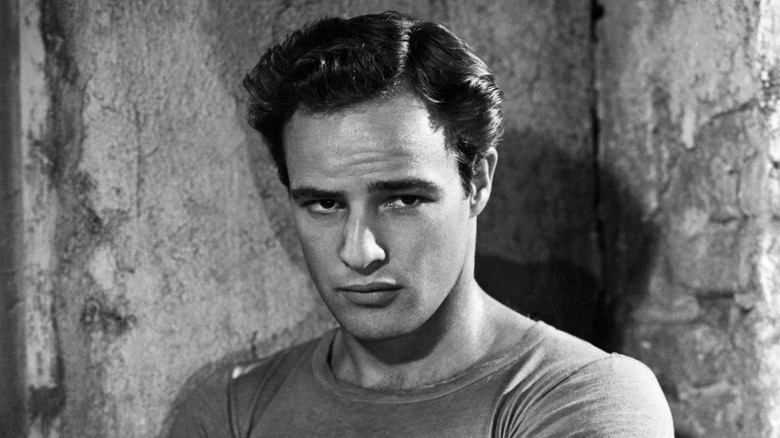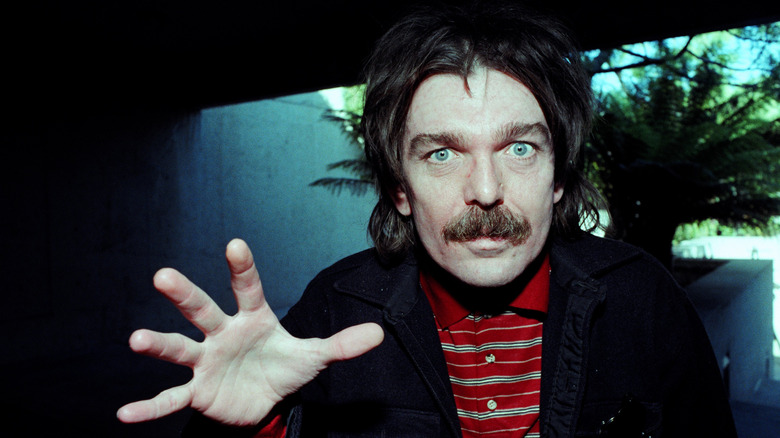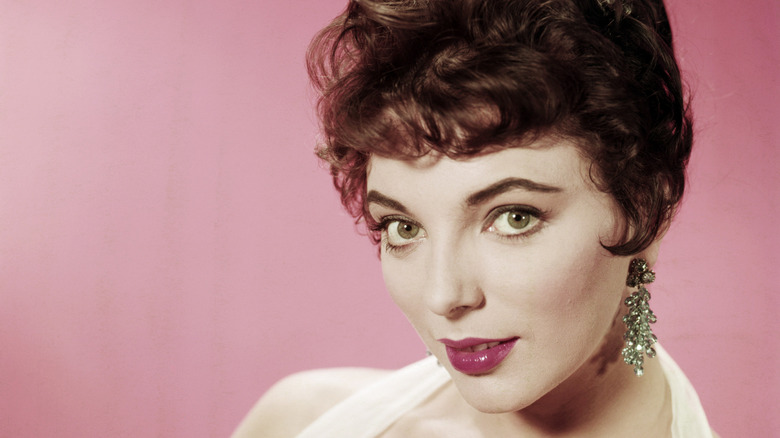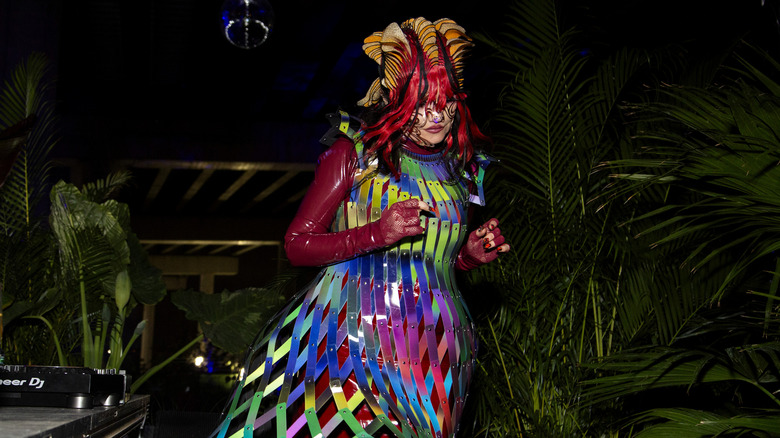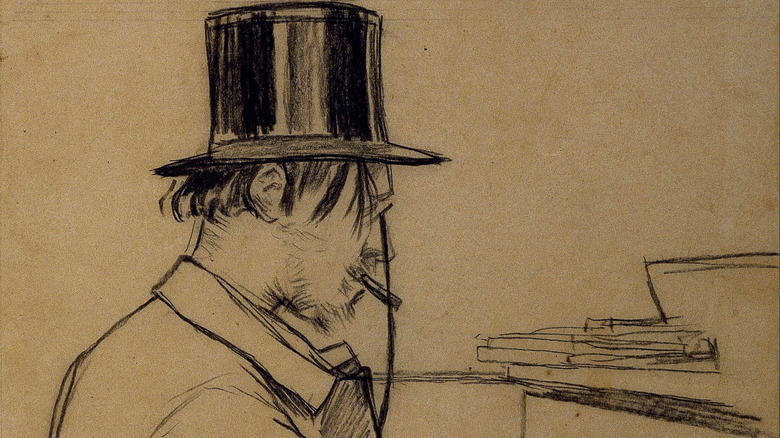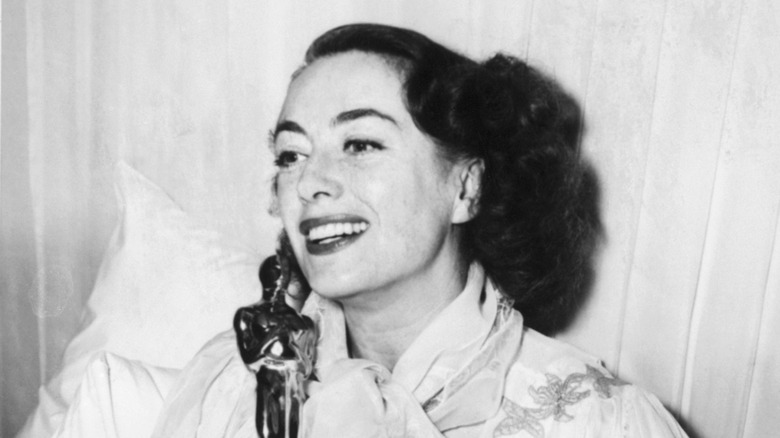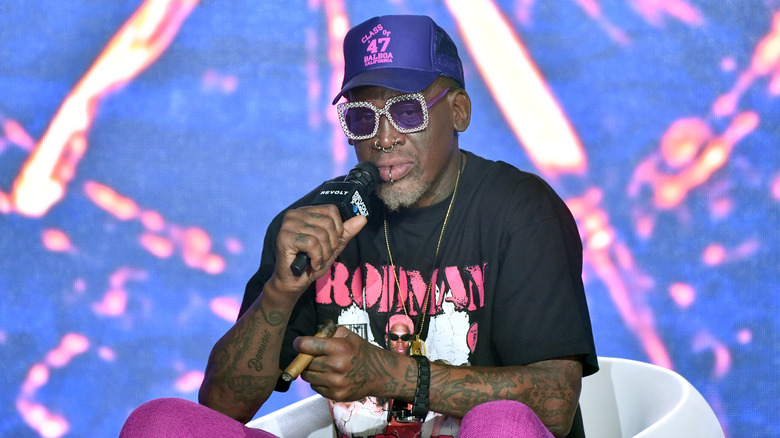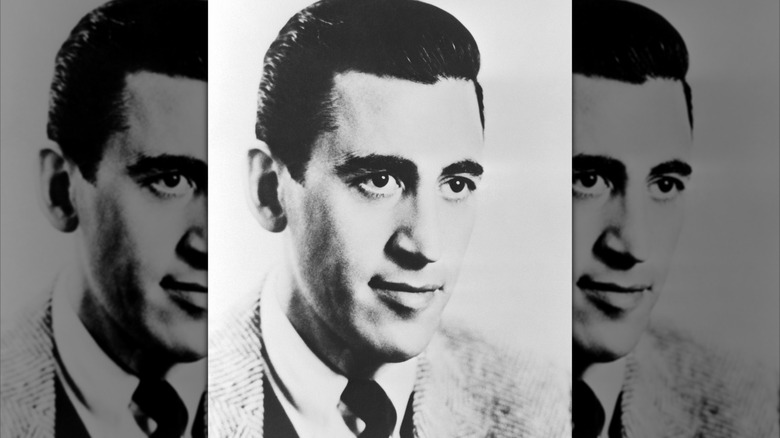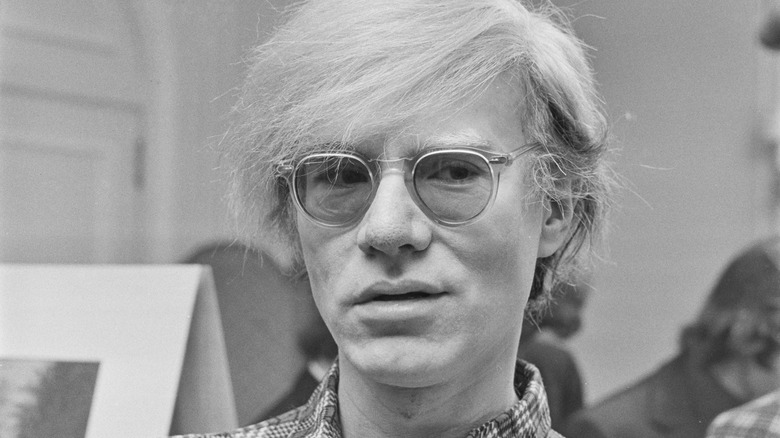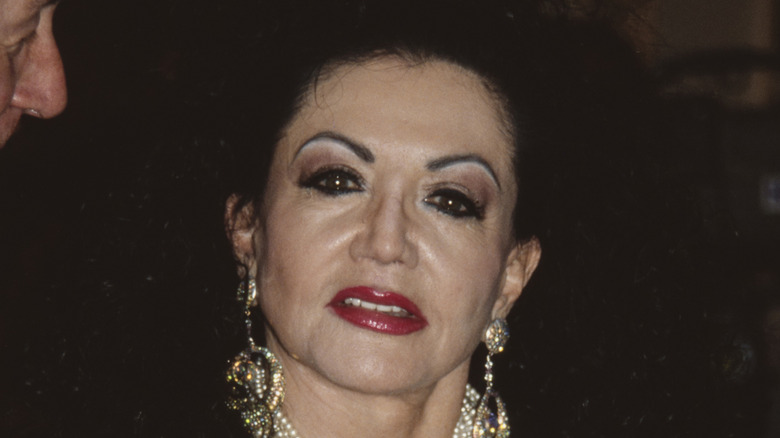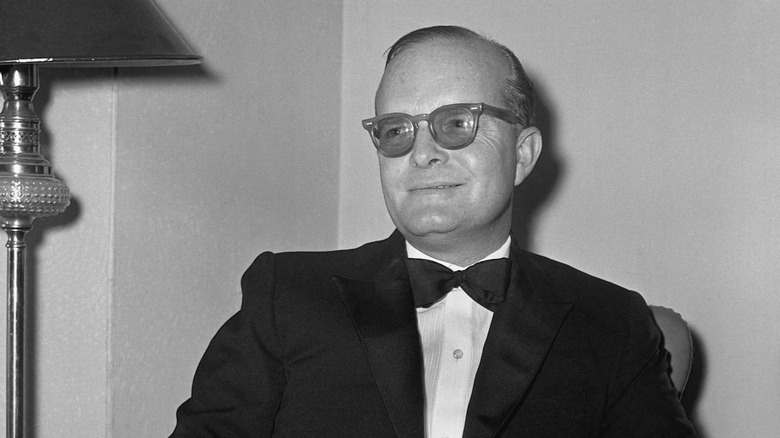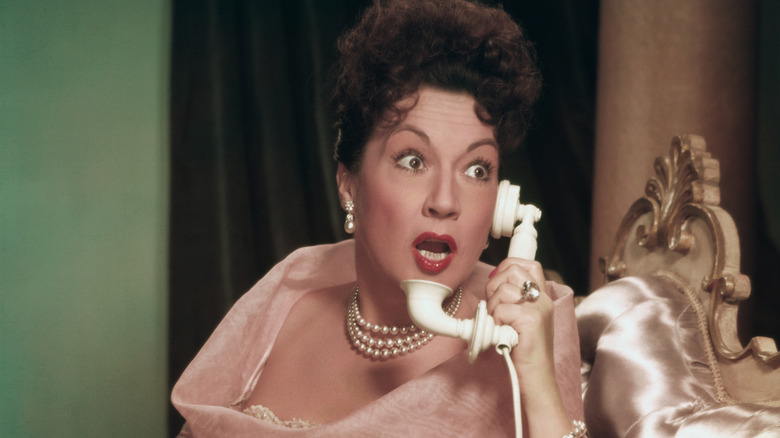Legendary Stars Who Were Beyond Weird
Who cares about a relatable celebrity? Celebrities occupy places of luxury and privilege because enough people think they're somehow special: talented, beautiful, athletic, what-have-you. It's unreasonable to expect that people who are elevated to such lofty perches would remain unchanged by all the praise and glamor. Instead of looking for celebrities who manage this stability of outlook (or who appear to), it's more fun to look for those who either allow celebrity to make them weird — or who were weird when fame found them and let the extra attention crystalize their eccentricity.
Exotic pets, weird feuds, out-there wardrobes, and unusual fixations are examples of what we, the public, should encourage in more celebrities. In a world that seems ever more dangerous and insecure, where change is constant and stability an illusion, we can draw comfort from the fact that Bjork is wearing a neon birdcage. Ladies and gentlemen of the performing world, we beg you: Get weird. We need it.
Tallulah Bankhead
Tallulah Bankhead, bless her bawdy heart, was always more of a "personality" than an actress. That's not to say that she wasn't an extremely gifted performer, originating the role of Regina in Lillian Hellmann's Southern gothic family drama "The Little Foxes," but that the enormity of Tallulah-the-Concept dwarfed her acknowledged successes. The daughter of a (one-term) Speaker of the House, Bankhead loved smoking, drinking, and sex and made no secret of it, blaring details in a loud, low voice that earned her the nickname "the Alabama Foghorn." Her pet parakeet even got in on the action after Bankhead taught it to share her champagne.
As much as she loved sins of the flesh, Bankhead was also a principled woman, campaigning for politicians she agreed with and, after the fall of France in 1940, swearing off alcohol until the Allies retook Paris. During the McCarthy era, she took a through-the-uprights approach: She hated both communists and the McCarthyite witch hunters. Onstage, she would do cartwheels when she could fit them into the script, and she later raised eyebrows on the set of the middling Hitchcock thriller "Lifeboat" when she arrived on set without panties, which was made apparent in certain situations and caused trepidation regarding what to do about it.
Even as she succumbed to her seemingly limitless taste for booze and pills later in life, she never lost her self-awareness. Asked by passersby on the street if she was Tallulah Bankhead, her stock answer was "I'm what's left of her, dahling," per The New Yorker.
Divine
Divine, John Waters' gleefully crass, stage-devouring muse, may have been the most influential drag queen that ever lived. Divine changed the art form so completely that it's hard to remember that before her, drag was dominated, at least outside ballroom culture, by staid performers often going by the term "female impersonators." Divine was fat, weird, and raunchy, more Miss Begotten than Miss America, and her career made cross-dressing punk.
Born Harris Glenn Milstead, Divine starred in several John Waters films, notching credits like avatar of obscenity Babs Johnson in "Pink Flamingos," fame-crazed murderess Dawn Davenport in "Female Trouble," and lovelorn divorcee Francine Fishpaw in "Polyester." She shaved part of her head so there was more room for makeup and was boldly plus-sized in a world that valued slimness in both its women and those who wore their clothes.
Beyond the Waters oeuvre, Divine made forays into marginally more mainstream projects, recording a couple of disco singles, launching a cabaret act, and taking a stage part in a women-in-prison farce. He was about to guest-star on an episode of "Married... with Children" when he died of unexplained heart failure at 42. Fortunately for queer kids everywhere, Divine had a cameo of sorts from beyond the grave as the key inspiration for the ferocious, full-figured octopoid witch Ursula in Disney's "The Little Mermaid."
Marlon Brando
To an extent, beauty is subjective, but there are limits: No one is going to make a credible argument that the young Marlon Brando wasn't one of the most handsome men ever to grace a Hollywood screen. His beauty was matched by a natural acting style that some directors highly prized. If getting that face and that style meant dealing with the kind of person who once allegedly urinated on stage scenery while scene partner Tallulah Bankhead was delivering her lines, well ... he was awfully pretty. Deceitful, mischievous and promiscuous, Brando got away with it all based on his talent and looks (and, per Rita Moreno, being an excellent if unfaithful lover).
Brando aged into one of the acknowledged screen talents of his generation ... and then out of it, with one of his final film roles as the title character in the universally panned 1996 "Island of Dr. Moreau." The production admittedly ran into many, many problems, but Brando's antics were among the most disruptive. Admittedly, he was still grieving the unexpected death of his daughter, but he nonetheless showed up in a muumuu with his face painted white. He squabbled with admittedly obnoxious co-star Val Kilmer and, disturbingly, became fixated on a little person who was in the cast and had him dressed like a smaller Brando, ultimately inspiring Mini-Me from the Austin Powers movies.
Brando's last credit was as the voice of a villainess in the unreleased animated film "Big Bug Man." He showed up in full drag, filmed a day of lines, and died before the film was complete.
Wendy O. Williams
Even more than being weird, Wendy O. Williams was cool. She was working in a radical erotic theater group started by Rod Swenson, and the two of them would go on to form the nucleus of the Plasmatics, a decidedly punk but also uncategorizable band. The Plasmatics became notorious for putting on some of the wildest performances audiences had ever seen, with charismatic Williams at the front of the group. Props were blown up, smashed, or riven with chainsaws at Plasmatics shows, and Williams performed in daring costumes, including sometimes just clouds of shaving cream or black tape over her nipples. On at least one occasion, she took the stage bearing visible marks of a recent police beating.
Williams was also party to one of the most surprising feuds in pop culture history. Later in her life, she became a bit of a health nut and an animal rights activist, she took healthy food seriously and publicly lamented the amount of sugar in processed foods. Williams failed to transition happily to "normal" life after her star faded and died by suicide in 1998. One hopes that, wherever Williams is, the rare honor of having a minor Super Mario antagonist, Wendy O. Koopa, named for her.
Captain Beefheart
Captain Beefheart was born plain old Don Vliet in Glendale, California, upgrading his name to Don Van Vliet before coming up with the Captain Beefheart stage name. He was a talented visual artist even as a child and was high-school friends with fellow eccentric rocker Frank Zappa, working with Zappa on a (sadly unperformed) rock opera. Beefheart formed a band, but without any formal musical training, was left needing his drummer to transcribe and arrange tunes that Beefheart would whistle or peck out on the piano. Band members later described this time as at best unpleasant — Beefheart was not a particularly sweet or cooperative man — but the resulting album, "Trout Mask Replica," became a peculiar cult success.
Beefheart churned through backing bands and released music with Zappa, but by 1982 he turned back to his original strength and left music behind to pursue visual art. He was not particularly suited to the working artist's life: he refused to go to New York in part because he thought there were a lot of skin flakes in the air, and audiences saw his work as meager efforts by a musician changing tacks. Reverting to his old name Don Van Vliet, he was reclusive in his last years, often skipping his own art openings, stating that he was happier at home painting.
Crispin Glover
Crispin Glover has constructed a niche for himself as one of "those" actors, an out-there artist for whom the lines between Crispin Glover the person, Crispin Glover the actor, and whatever role he's currently playing blur. He's good at grabbing headlines for strange behavior like the time he went on the David Letterman show and almost kicked the host in the head — with a platform shoe.
Glover rewrote one character, the villain in the 2001 "Charlie's Angels" reboot, to be completely silent, using the money to invest in his own project and buy himself a 17th-century chateau (his word) in the Czech Republic, the grounds of which he has stocked with peafowl. Despite the opulence this property implies, Glover has a history of objecting to the idea that money can buy happiness: He was reportedly so frustrated that the ending of "Back to the Future" implied that wealth would fix the McFly family's various woes. When stock footage and prostheses were used to replicate Glover's appearance in the sequel regardless, he sued, hoping to make clear that he had nothing to do with the subsequent movie.
Glover also seems happy to brush off his reputation for eccentricity. He clarifies that he is not "psychotic" (again, his word), but he is otherwise seemingly content to make movies among his Czech peafowl and let the world think what it thinks.
Joan Collins
Joan Collins — Dame Joan Collins, as the elegant and apparently immortal actress has been knighted — has remained a topic of interest well past the point when many of her contemporaries have faded or, bluntly, died, in part because the experience of Joan Collins has remained intact and fantastic. Interviewers frequently come away with a tidbit of eccentricity, often connected to the maintenance of her famous beauty: For example, she insists on lying down with her face under cool cloths for at least five minutes before public appearances, and she won't sleep on her side for fear it crumples the face.
Non-Joan Collins topics Joan Collins has spoken about include the reincarnation of her sister, romance novelist Jackie Collins, whom Joan suspects visits her in the form of flying insects. She's been accused of being unsympathetic to victims of sexual harassment in public comments in part because of her own no-nonsense attitude to men who tried to take liberties: She kneed them in the crotch. Magnificently, she's married to a man (her fifth husband) who is over 30 years her junior. Asked about the age gap, she simply said "If he dies, he dies." Joan Collins in her 90s remains exactly Joan Collins, and what a gift to the world that is.
Prince
In 1993, Prince changed his name to an unpronounceable symbol that married the common symbols for the male and female genders. This may have been a ploy to get out of a recording contract, but it was still a fairly eccentric choice of stage name, and in the absence of better options most people simply began calling him "The Artist Formerly Known As Prince." This strange choice was on brand for the musician, who had blazed a trail of sexy androgyny even as he struggled to reconcile his erotically charged stage persona with his religious beliefs.
Prince had been raised a Seventh-Day Adventist, and as an adult was associated with the Jehovah's Witnesses. This led him to occasionally take part in door-to-door evangelization (pity the homeowner who answered that knock in a mere bathrobe) but also led to inconsistent opinions on sex and sexuality that alienated some fans and collaborators. Later in his career, he ejected some of his old songs from his active repertoire, partially turning his back on the sexiness that had helped him top the charts.
Less controversially, Prince was a notoriously wacky eater, with tastes ranging from the kangaroo-themed snack Dunkaroos to yak milk, which he ate with his cereal. He also adored mustard, stocking his fridge with a kaleidoscope of foreign and domestic brands. His favorite mustard, reportedly, contained raspberries.
Bjork
Icelandic musician Bjork is so known for her playful, outre red-carpet looks that she's at her most startling when her face is visible. We know what Bjork's elfin, usually eyelinered-up face looks like, but it seems rude to look directly at it. Instead, she seems most herself with her head covered in petals or spikes, in a fungus-like full-body contraption complete with spore-bearing fruiting bodies, with her face fully covered in crystals, or any of the dozens of instantly iconic yet completely unreproducible looks she's detonated meet-and-greets with over the years.
Beyond the outfits (it seems too limiting to call them "clothes"), Bjork is as whimsical as they come, once accepting an award with the phrase "I am grateful grapefruit." An Irish journalist reports arriving to interview Bjork to find the singer wearing a Miss Piggy mask, which she kept on throughout their talk. When the journalist woke up after a night of partying with the star and her entourage, he found Bjork had gently placed the mask over his head as he slept — then left. Bjork pranked a larger audience in 2009 with a false announcement that, given Robert Plant's reluctance to rejoin the band, she would be fronting Led Zeppelin. This was an April Fool's joke, alas.
Erik Satie
Music scholars know Erik Satie as one of the forerunners of 20th-century musical minimalism; casual fans know him as the composer of the perennially popular "Gymnopédies." Fans of the eccentric remember him as one of the weirdest men ever to place his hands on the piano.
Satie's love of repetition and experimentation led him to write the seldom-performed "Vexations," the longest piano piece ever produced. It consists of a single musical phrase repeated 840 times. (Satie recommended spending time motionless and alone to prepare for a performance.) He may have been the first person to conceptualize background music, and he riposted against criticism of his work as formless with a (seven-part) piece called "Three Pieces in the Form of a Pear." All this innovation came from someone who had flunked out of music school as a young man, only to return in his 40s.
Outside his music, he was also an odd duck. He dressed in white and ate primarily white foods, with a hair-raising inventory including sugar, animal fat, moldy fruit, boiled chicken, turnips, and coconut. He carried a hammer for protection on his long walks to and from performances and apparently collected umbrellas: At his death, over 100 were found in his apartment.
Joan Crawford
For decades, Joan Crawford was one of Hollywood's most prominent and glamorous stars. While she spent her career maintaining a carefully crafted image of perfection, her personal life revealed that behind the elegant clothes, dramatic makeup, and unquestioned star power, Crawford was a tad bizarre.
Crawford concealed her birth year so completely that even today, no one is quite sure in what year she was born: "1906 or so" is the best researchers can do. Devoted to her maid, Crawford sometimes traveled with her, and when Crawford referred to the (German) woman by the nickname "Mamacita," those around her apparently often thought Crawford's employee was her actual mother. Neat-freak Crawford had tailor-made plastic covers for her furniture, the better to scrub it all down, but this love of order didn't wholly extend to germophobia, it seems: Crawford had a fridge in her bathroom.
Crawford's legacy is tarnished by her adopted daughter's memoir of her difficult upbringing, but the star was widely active in charity work, including some causes that might seem niche for a star of her caliber. Brandeis University holds a collection of her awards, and while they don't have her Oscar for "Mildred Pierce," they've preserved a gilded leg brace from the Texas Theatres Crippled Children's Fund and a decorative proclamation from the Carbonated Beverage Syrup and Allied Trades Division of the United Jewish Appeal of Greater New York, among other tokens of gratitude.
Dennis Rodman
The fact that a late growth spurt saw Dennis Rodman gain seven inches in height in college barely makes the list of oddest things about the NBA star. An aggressive player and an absolute rebound machine, his unquestioned skill on the court was regularly overshadowed by Rodman's other exploits. He pitched hissy fits on and off the court, experimented with body art before it was as common among athletes as it is now, and was briefly married to "Baywatch" babe Carmen Electra before staging a subsequent wedding — to himself, wearing a full white gown. (Admittedly, the dress flattered him.)
Rodman also made diplomatic waves with his attempts to befriend reclusive dictator Kim Jong-Un, the North Korean caudillo who regularly threatens world war. Rodman first visited Pyongyang in 2013 and apparently bonded with Kim somehow, later referring to the man who killed his own uncle with an anti-aircraft gun as a "friend for life." In 2014, Rodman even sang "Happy Birthday" to Kim in North Korea before a crowd of thousands. The United States has banned travel to North Korea and relations are now even colder, but perhaps Rodman can still get a card across the border.
Shirley MacLaine
Shirley MacLaine has enjoyed a long and colorful career in cinema, playing a string of good-hearted sex workers in her youth and then aging into a number of roles as acerbic older women who deliver lines like firecrackers. Not many performers have the range for the title role in "Sweet Charity" and the acidic Ouiser Boudreaux in "Steel Magnolias," but MacLaine made both roles her own.
As a young performer, she earned herself a quaint footnote in diplomatic history by performing a sexy can-can for visiting Soviet premier Nikita Khrushchev. ("Khrushy" claimed to be unimpressed by the decadent Western sleaze, but in pictures, he looks as pleased to meet a young Shirley MacLaine as most heterosexual men would be.) Later in life, MacLaine became interested in broad-spectrum mysticism, exploring, writing about, and popularizing practices like meditation and out-of-body experiences. She wrote and spoke widely about these forms of spirituality, gaining herself dueling reputations as a mystic and a kook while also managing the interest of people who wanted to meet Shirley MacLaine the star, not join the actress in her spiritual delving.
MacLaine even produced her own takes on the celebrity exercise video, recording an audiobook version of her guided meditations about the chakras and filming "Shirley MacLaine's Inner Workout," which video stores could barely keep on the shelves after its 1989 release.
JD Salinger
In 1953, as his fame for "Catcher in the Rye" and "Nine Stories" was cresting, author J.D. Salinger instructed his agent to burn his fan mail as it came in and decamped to a rural hillside in New Hampshire, where he would remain for the rest of his long life — he died in 2010 at the age of 91. Salinger had tasted fame and apparently decided he wanted none of it, even quitting publishing after the mid-1960s. Unfortunately, the life of a hermit is interesting to the outside world, and Salinger never fully escaped others' interest, fending off regular attempts by outsiders to get a glimpse or a quote.
Books published by an ex-lover and by Salinger's daughter allegedly revealed strange and sinister sides of Salinger's hermit-like existence. They describe an abusive husband with a perverse diet, eating frozen peas for breakfast and consuming his own urine. These works also reported a tendency to follow religious and spiritual fads, even from his secluded hideaway: Salinger even seems to have joined his fellow celebrities in going through a Scientology phase.
Andy Warhol
The persona of Andy Warhol was, per Warhol himself, a straightforward creation, with no particular hidden meaning or complexity below the surface. This may well have been the image he intended to project, but biographers and researchers have pieced together more nuanced views of the artist who largely defined the artistic world of the late 20th century.
Shy and sensitive behind the veneer of superficiality, Warhol enjoyed lying about where he was born, claiming various Midwestern cities as the mood took him (Pittsburgh had the honor.) He hired an actor to portray him at one event, and on a television panel show spoke only through his friend Edie Sedgwick. Warhol's dyslexia meant he found writing difficult, so he journaled almost obsessively by speaking into a tape recorder he nicknamed his "wife." Researchers may listen to these tapes, but their transcription is forbidden until 2037.
Domestically, Warhol didn't live in the opulent or outre surroundings you might expect, but from 1952 he had his mother live with him, joining her for Catholic services and speaking to her in Rusyn, a cousin of Ukrainian. While Warhol presented himself as asexual, he was interested in sexuality as a human activity, as is clear from his work — and a cache of erotic drawings from his early career hints at suppressed, deferred, or concealed desire.
Bill Lee
Red Sox Pitcher Bill Lee was so outspoken that he rapidly garnered the nickname "Spaceman" at the beginning of his career. A skilled player, Lee built his fame as much on his brash attitude and quick wit as on his athletic skills. He told a team doctor that an X-ray artifact was an old Scotch bottle cap he'd swallowed, and announced that marijuana-laced pancakes made him invulnerable to air pollution. He kept his spark into retirement, comparing an aged rival to a duvet cover.
Lee was known for being extremely personally loyal, once eating a $500 dollar fine for walking out in protest when one of his friends was traded despite the fact that this friend was not getting much time on the diamond. This clash with management got Lee himself traded from the Red Sox to the Montreal Expos, where he finished out his Major League career. Later, he wrote two memoirs, an alternate history of the Red Sox, and features for both "Sports Illustrated" and "High Times." In 2012, under a one-day contract with a minor league team, he became the oldest pitcher to win a baseball game, beating his own record from two years prior.
Lyndon LaRouche
Lyndon LaRouche ran for president eight times, though you could be forgiven for not immediately recognizing the name. The conspiracy theorist and general weirdo never came particularly close to the Oval Office, and though his followers occasionally snagged ballot lines, none rose to the level of genuine political influence. Despite his limited success, at his apex, his acolytes staffed 63 offices across the Americas and Europe.
At the start of World War II, LaRouche received conscientious objector status because of his Quaker upbringing before apparently changing his mind and joining the army anyway. Initially a Marxist, he veered right over the course of his adulthood, though in some ways his views defied conventional categories. Per LaRouche, Queen Elizabeth II was trying to kill him, and Henry Kissinger was a gay contract killer. Racist but opportunist, LaRouche had political marriages of convenience with both the Nation of Islam and the Ku Klux Klan, even though he allegedly thought the latter group had been set up by Jews.
LaRouche hated modern music and particularly rock, which for him was part of the many-tentacled British conspiracy infiltrating American life, and perhaps predictably, considered climate change a hoax. He was equally willing to turn his ire on smaller targets, though: He also accused the Leesburg, Virginia, Garden Club of being a hive of communist agitators.
Jackie Stallone
Jackie Stallone, mother to Sylvester and his siblings, actually ran away to join the circus as a teenager in 1930s Washington, DC, notching two years as a trapeze artist before taking a job as a chorus girl. In between two marriages and the birth of three children, she worked to promote women's athletics. This interest eventually drew her into the world of female wrestling, and she appeared on the original Gorgeous Ladies of Wrestling in the 1980s. Irrepressible Jackie stayed active into her 90s, maintaining a trapeze practice schedule in her 10th decade.
Stallone's interest in astrology was what eventually made her a minor celebrity, especially her own niche form of divination: rumpology, which is exactly what it sounds like. Per Stallone, the cleft nature of the buttocks mirrors that of the brain, with features and textures of the posterior reflecting aspects of a person's life and fate: left cheek for the past, right for the future. Stallone attempted to connect this practice to various ancient peoples, but she seems to have been denying herself credit for coming up with one of the most peculiar forms of fortunetelling ever devised.
Truman Capote
If you name a baby Truman Streckfus Persons, you can't expect them to follow a conventional path. After a chaotic upbringing that saw, among other shufflings, Truman's adoption and renaming by his mother's second husband Joe Capote, Truman became a literary sensation in his early 20s, building a reputation not just as a writer, but as a then-rare out gay man whose behavior was as much a contributor to his fame as his prose. He spoke with an affected lisp, dressed boldly, and reinvented himself as a New York socialite.
Capote loved to hobnob with the wealthy, cultivating friendships with people he thought were important. With his career never quite living up to its early promise, he turned from fiction and drama to true crime, writing the seminal crime story "In Cold Blood" and developing an emotional relationship with condemned murderer Perry Smith. Speculation about Capote's relationship with Smith has run the gamut from cynical manipulation of a source by Capote to star-crossed love; the murderous Smith was certainly of a type with the violent men Capote often pursued. The success of "In Cold Blood" allowed him to throw a colossal party at New York's Plaza Hotel in November 1966, which in retrospect was the high point of Capote's life.
Addicted to alcohol, drugs, and unhealthy relationships, Truman spiraled, ultimately sabotaging his relationships with the influential and elite women of New York society with a gossipy article published in Esquire in 1975. Capote died just short of his 60th birthday in 1984.
Ethel Merman
If you had to explain camp (the adjective) to a recent arrival from a far-off planet, you might begin with Ethel Merman. The big-voiced singer with the big stage personality, almost invariably described as a belter, absolutely shook the rafters of theaters up and down Broadway in 13 star turns in musical theater. She never quite made had the same success in film or TV: Something about her had to be seen to be believed.
Merman had a schtick, and it wasn't just for the stage. Once, when bored by another singer's performance, she audibly gargled her champagne. Her brief, apparently ill-advised marriage to fellow "character" Ernest Borgnine foundered when he got traveler's diarrhea, and Merman, already annoyed at him for scheduling personal appearance gigs during their honeymoon, hid his medicine. In her memoir, the chapter "My Marriage to Ernest Borgnine" is a blank page.
Ethel Merman stayed sassy to the end, appearing as a delusional lieutenant "who thinks he's Ethel Merman" in "Airplane!" and releasing a disco album. Though she died in 1985, some say her bawdy ghost still haunt's Broadway's Imperial Theater.

